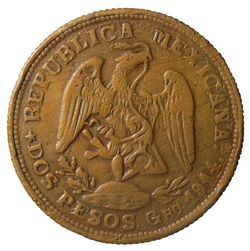Guerrero Dos Pesos Series: addition to the catalog
by Angel Smith Herrera
This is a new find in the Guerrero Dos Pesos. The die combination is well known and it actually made its debut in Howland Wood’s The Mexican Revolutionary Coinage 1913-1916, published in 1921, where we find this particular die combination listed as 30a (see his plate XIV) which he uses to illustrate a sub-variety of the standard two pesos “Sun over Mountains” Guerrero type. Other catalog numbers have been assigned to this particular unique die combination, which is always listed as struck on a silver planchet (i.e. Guerrero 12h by Leslie-Stevens) but current collectors may be more used to Guthrie-Bothamley’s Mexican Revolutionary Coinage 1913-1917 (hereinafter “GB”) catalog numbers, which would put it as GB-218, that being a unique marriage of their dies Obverse V and Reverse F, which are the same die numbers found in Carlos Amaya’s Compendio de la Moneda Revolucionaria Mexicana, who lists the silver strike as his A-GO-161.


Obverse V Reverse F
This coin is struck on a copper planchet and to my knowledge it is previously unreported in such metal. Learning of the existence of this coin triggered a search (not exhaustive) on the most common references and auction catalogs of important revolutionary collections, revealing no listings or records of sales. Interestingly, such research and analysis of actual die state and strike of many photographs of the silver strike reveal that this is very likely a “trial strike” of freshly prepared dies prior to their use for regular production of silver coinage, something that others may call a “pattern”, while I prefer the first term. This conclusion is easy to reach since the copper striking reported herein lacks the die breaks and die damage present on both sides (in addition to other die breaks that appeared later on and even the die clash evident on most pieces): further, the coin was carefully struck with good pressure on a good planchet leaving a complete impression of all legends and die features, something that I have not seen on the regular silver strikes which suffer from weak and incomplete strikes. It is worth mention that at this time I know of two specimens of the copper strike and both feature a good and complete strike in a degree not found on the silver ones.
As with any newly discovered types or varieties there is a need to rule out the possibility of having a counterfeit, particularly in this specific series where some copper counterfeit strikes (which seem to be made from impact transfer dies) are known and have even been reported as real. My analysis of these coins rules out that possibility based on style, strike, size, edge reeding and my personal experience handling this type of coins, supported by the opinions of several numismatic friends who have examined it. Should you decide to study the coin presented herein further, you will note that there are practically no available good (complete) silver strikes from which to produce transfer or electroplate dies or even a mold to cast a similar piece. Also, since this is a unique die marriage of dies V and F as identified above, you may not resort to “copying” or using one side of a well struck coin for the obverse and that of a different well struck coin for the reverse. Moreover, as mentioned above, this is the earliest die state I have found for this particular set of dies.
